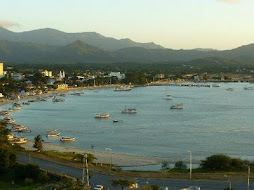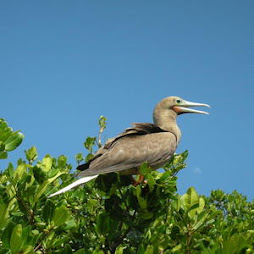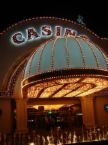According to The Ecotourism Society, ecological tourism "purposeful travel to natural areas to understand the culture and natural history of the environment, taking care not to alter the integrity of the ecosystem while producing economic opportunities that make the conservation of natural resources beneficial to local people."
EIGHT CHARACTERISTICS OF ECOTOURISM*
1. It must promote positive environmental ethics - fostering preferred behavior in its participants.
2. It does not degrade the resource - There is no consumptive erosion of the natural environment visited.
3. It concentrates on intrinsic rather than extrinsic values. Facilities and services may "facilitate" the encounter with the intrinsic resource; they never become attractions in their own right, nor do they distract from the natural attraction itself.
4. It is biocentric rather than homocentric in philosophy. Ecotourists enter the environment accepting it on its terms, not expecting it to change or be modified for their convenience.
5. It must benefit the wildlife and environment. If the environment has not at least achieved a net benefit toward its sustainability and ecological integrity, then the activity is not ecotourism.
6. It is a first-hand experience with the natural environment. Movies and zoological parks do not constitute an ecotourism experience. Visitor centers and interpretive slide shows are included.
7. It has an "expectation of gratification."
8. It has a high cognitive and effective experiential dimension.
*James R. Butler,Ecotourism: Its Changing Face and Evolving Philosophy, Department of Forestry, University of Alberta, Canada, 1992
http://www.windfind.com/islandguide.htm
http://www.venezuelatuya.com/margarita/playaseng.htm

WELCOME TO MARGARITA ISLAND!
Come with us to enjoy the best way to travel through Margarita Island.
In the Island you can find tour guides in English, German, Italian and French languages are in charge of our jeeps while you’re visiting the most important places of Margarita such as:
- “THE FORT OF SANTA ROSA” in “LA ASUNCION”, the political capital of Margarita Island. This fort is a place full of history and has a nice panoramic to the mountains, the city and the ocean.
- Our second place is a small town called “EL VALLE DEL ESPIRITU SANTO” where tourists could get acquainted to the culture, the religion and the traditions of Venezuela.
- Our third place is “LA RESTINGA NATIONAL PARK” where there’s a big swamp which is about 25 square km. This visit includes a boat ride on the lagoon into the mangroves and it takes about 40 min. to appreciate its natural flora and fauna.
- Our fourth place is “PUNTA ARENAS BEACH” on the peninsula de Macanao where you can enjoy one of the best beaches of Margarita Island with a delicious lunch in a typical Venezuelan restaurant. Visitors would spend about two hours for lunch and go swimming.
-Then “LA CARMELA”, a place where you can appreciate cactus and dunes into the nicest landscapes of Macanao.
-At last a brief stop in a grocery store called “COCO LOCO” where tourists could order a tropical natural refreshing coconut milk shake called “Cocada”.
-Before going back to the hotel, we visit the “Juan Griego Bay” so you can appreciate the commercial activities such as fishing and the duty free shops...
Retrieved from Margarita Island
General information about Venezuela:
* Capital - Caracas
* National Bird - The Turpial (Icterus icterus)
* National Flag - The Venezuelan flag is rectangular, with three horizontal stripes of equal width: yellow, blue, and red. Yellow stands for the richness of the Venezuelan earth. Blue, for the immense sea separating Venezuela from Spain. Red, for the blood that was spilled in the battles for independence.
In the center of the blue stripe there are seven stars in the form of an arc, representing the seven original provinces that formed the Capitania General of Venezuela declaring their independence on July 5, 1811. The Coat of Arms has been added to the upper left corner of the flag.
* National Anthem
* Coat of Arms vz_coa.gif (65010 bytes)
* National Flower - The orchid (Cattleya mossiae).
This kind of orchid is also known as Flor de Mayo (May Flower).
* National Tree - The Aragüaney (Tabebuia chrysantha)
* Independence Day, July 5th
For more information please click: VENEZUELA
What is Margarita Island?
“Margarita Island (Spanish: Isla Margarita or Isla de Margarita) is the largest island of the Nueva Esparta state in Venezuela, situated in the Caribbean Sea, off the northeastern coast of the country. The state also contains two other smaller islands: Coche and Cubagua. The capital is La Asunción, located in a river valley of the same name. Primary industries are tourism, fishing and construction. Its population is about 420,000” (Wikipedia, 2009).
History
“In 1498, Christopher Columbus discovered Margarita Island. The local natives, named Guaiqueries, received the conquering Spaniards with open arms unaware that they later would become slaves of their own wealth. Pearls represented almost a third of all New World tribute to the Spanish Crown. Margarita Island had to be fortified against the increasing threat of pirate attacks, and several of these fortifications remain today. In 1561, the island was seized by Lope de Aguirre, a notoriously violent and rebellious conquistador who held the islanders in a grip of terror until he returned to the mainland in an attempt to take Panama from the Spanish crown.In 1814, the islanders fought successfully for independence from the Spanish after the collapse of the First Republic of Venezuela. Margarita Island became the first, permanently free territory in Venezuela. That same year, Luisa Cáceres de Arismendi was detained for over three years in a dark dungeon where she was harassed and abused. The authorities were hoping to put pressure on her husband Juan Bautista Arismendi, who was fighting for independence. It was on Margarita Island that Simón Bolívar was confirmed as Commander in Chief of Venezuela in 1816. From there he started a nine-year campaign to free Venezuela, Colombia, Ecuador, Peru and Bolivia from the Spanish Crown”(Wikipedia, 2009).
Geography
“Located in the Caribbean Sea between latitudes 10°52'N and 11°11'N and longitudes 63°48'W and 64°23'W, it belongs to the State of Nueva Esparta which also comprises the islands of Coche and Cubagua. The island is formed by two peninsulas joined by an isthmus. It covers an area of 1,020 km². It splits into two sections linked by an 18-km (11-mi) spit of sand. It is 78 km long and its widest side measures roughly 20 km. The climate is very sunny and dry with temperatures from 24 to 37°C. Most of the island's 420,000 residents live in the more developed eastern part, especially in the city of Porlamar and adjoining city of Pampatar. Others are found in the much smaller city of La Asunción, the capital of the region or Juan Griego. Direct flights from Caracas and other Venezuelan cities, as well as scheduled or charter flights from a number of North American and European cities, ferries from Puerto La Cruz, Cumaná, and La Guaira also travel to the island. The Macanao peninsula to the west has a central mountain range in the east-west direction. The highest altitude is 760 m at Pico de Macanao. Several smaller ranges derive from this axis following a north-south orientation with deep valleys between them. The most notable of this valleys is San Francisco in the north-central part of the peninsula. The Paraguachoa peninsula to the East is formed by a mountain range in the north-south direction from Porlamar to Cabo Negro. The highest peaks are San Juan or Cerro Grande (920 m) and El Copey (890 m). Both peninsulas are connected by La Restinga, an isthmus of low altitude with a lagoon called La Restinga” (Wikipedia, 2009).
Main Cities: Porlamar, Pampatar, La Asuncion, and Juan Griego.
The biggest city on Margarita island is Porlamar, known for its commercial center; it flourishes with shops and good restaurants. About 85,000 people live there during the low season in Porlamar; about 125,000, in the high season. It has two city beaches (Wikipedia, 2009).
Beach near Pampatar
Is one of the largest towns on the island . Pampatar has around 50,000 citizens in its greater area. Most of the larger shopping malls are in its Jurisdiction: Sambil Margarita, Rattan Depot, Centro Comercial AB (Avenida Bolivar), and La Redoma. It has several beaches. It is the seat of the Castillo San Carlos Borromeo constructed approximately from 1664 to 1684 (Wikipedia, 2009).
La Asunción is the capital of the Federal State of Nueva Esparta with about 25,000 citizens. It is the seat of the regional government (Wikipedia, 2009).
Juan Griego is a city of around 45,000 people, it has small shopping centres and beaches. La Galera is a fortress not far off the city centre, where, in the early 1820s (Wikipedia, 2009).
Tourism on Margarita Island is increasing year on year. "The breathtaking scenery and excellent hotels and nightlife and duty-free shopping are all attracting foreigners. Margarita Island can usually be reached by ferry or by airplane, as the Santiago Mariño International Airport is located 25 kilometers away from the city of Porlamar. Its status as a duty-free port and proximity to the mainland make it one of the top vacation spots for Venezuelans. Vacationers crowd the island especially during Christmas time, Easter week, and from July to mid-September. Venezuelan tourists come on shopping sprees; whiskey, cheese, chocolate, and electrical appliances, are among the goods that can be purchased less expensively than on the mainland. Also, many retired people choose Margarita as an ideal, peaceful dwelling place.There are at least 50 unique and magnificent margarita beaches which are scattered along a 106 miles of coastline. Its location as an island in the Caribbean sea offers lots of beaches to explore which range from crowded to solitary and most of them virgin. Playa El Agua, in the north, is the most popular with 4 km of fine sand. Playa El Yaque is internationally known as an excellent location for windsurfing. Playa Parguito, Playa Caribe, and Playa Punta Arenas are also popular beaches. Many resorts cater to the international, Caribbean-loving crowd, especially from European countries. The beach of Playa Puerto Cruz is one of the most popular with tourists” (Wikipedia, 2009). All the above text was retrieved from WIKIPEDIA on June 9th, 2009





































































No comments:
Post a Comment